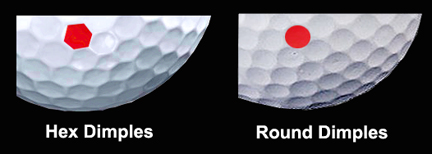There has been much discussion over whether the new Callaway Hex series golf balls are truly a “dimpleless” design.
Let’s take a look at the Hex Chrome, which is a 3-piece urethane covered ball, or what is traditionally considered a “Tour” ball.
This ball’s surface is covered in multi-sized, hexagonal shaped surface depressions vs. the traditional round dimples we are all used to seeing on other product.
The company claims the hex shaped structures increase coverage on the surface as the fret area between traditional round dimples is reduced.
You can see below the area between the round dimples has more of an hourglass shape vs. the hex structure configuration. The hex depressions fit together like puzzle pieces.

But is the ball really dimpleless? No, it just employs hexagonal dimples. And non-round dimples are nothing new.
The Davidson Rubber Company of Boston made golf balls in the early 1900’s that had dimple patterns so complex (a lattice of non-round dimple shapes and sizes) you would think they were designed with a high tech computer program.
What’s more, dimples on a golf ball are not “independent operators”. They work synergistically with the other components of the ball (core, mantle layers, etc…)
When a new ball design is ready, a dimple pattern will be designed or refined that tweaks the final performance of the golf ball. For example, the engineers will use or develop the right dimple pattern that results in the optimal trajectory and distance, for that specific ball construction.
So a hex, round, or other dimple pattern may be ideal for one ball construction, but not for another. In fact, the wrong dimple design on a given construction, no matter how high tech the pattern, can result in an absolute “dud” of a ball!
I’ll also add that the various ball companies have patents on particular dimple designs and layouts that prohibit competitors from using them. This can be a blessing in disguise as it leads to new innovations year after year as the companies work to avoid infringement.
By the way, the Hex series balls are quite nice. Ernie Els won the 2012 British Open with the HEX Black Tour Ball, a 5-Piece ball.
The Hex Chrome, the 3-Piece, has a softer core for more moderate swing speeds. It also spins well into the greens. Compared to >$45/dozen Tour balls, the Hex Chrome is ~$36/dozen depending on the retailer.
In all, I hope that helped clear up any dimple issues related to the new Hex product (or with dimples in general).
I have a full review of another interesting ball from another manufacturer on the way. It really tames the side spin (i.e. – driver slice), is low compression, but still playable into the greens. Watch for my notification it in your inbox.
Best Regards,
![]()
About the Author: Robert Cotter is a US patent award winning golf ball design engineer and fine player. His interaction with the top players in the game led to his discovery of The Key to a pro caliber golf swing. He is the author of “The Key To A Repeating Golf Swing” which has taught over 5000 golfers in 60+ countries.
